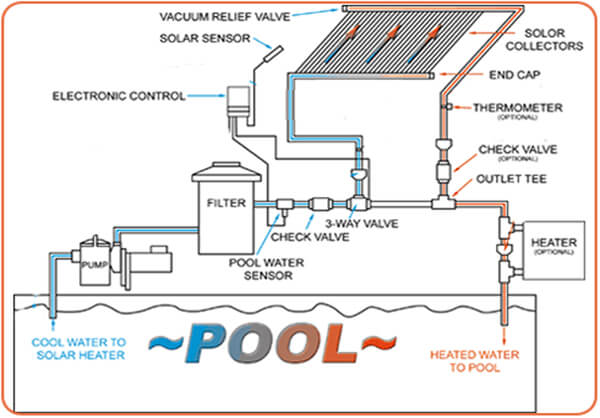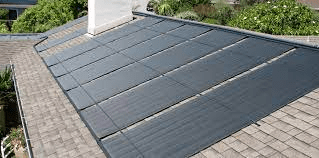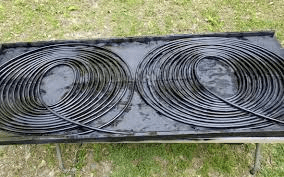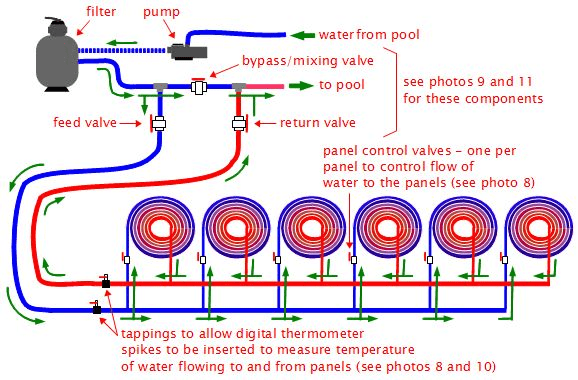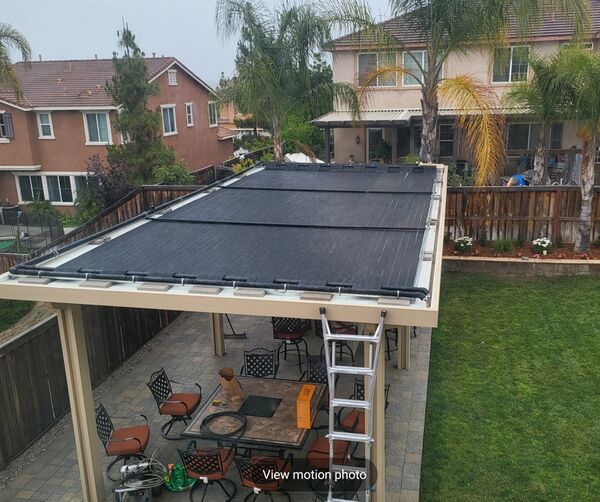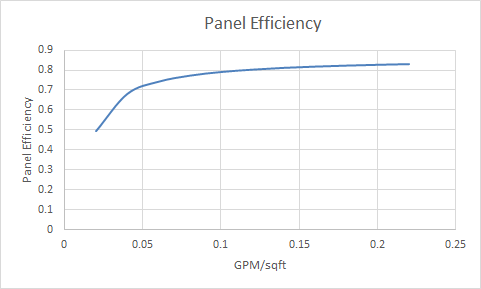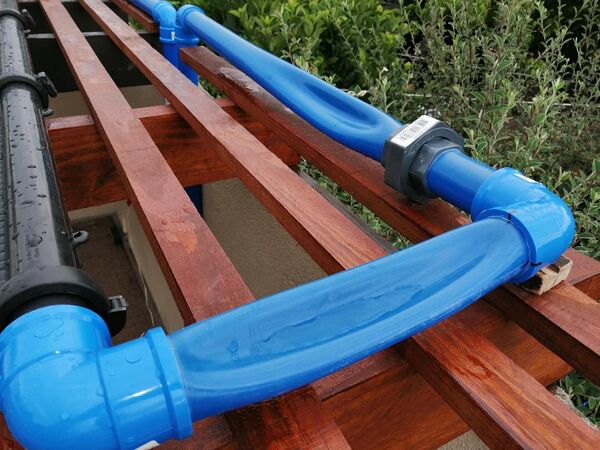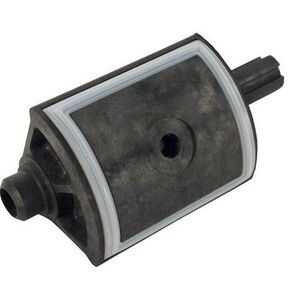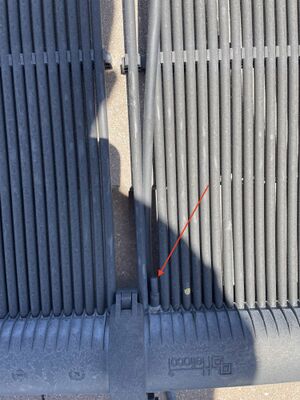Solar Pool Heaters
The Department of Energy (DOE) has a webpage describing Solar Swimming Pool Heaters. They say:
You can significantly reduce swimming pool heating costs by installing a solar pool heater. They're cost competitive with both gas and heat pump pool heaters, and they have very low annual operating costs. Actually, solar pool heating is one of the most cost-effective use of solar energy in some climates.
Bubble covers can make a huge difference in what you get out of a solar heater.
Solar Controllers
For maximum efficiency of a pool solar heating system a solar valve controller should be used. The controller has a solar temperature sensor, typically installed near the panels, and an actuator controlled valve. When the solar temperature sensor tells the controller the heat at the panels is greater then the pool water the solar valve is opened to flow water through the panels to capture the heat. When the solar controller senses there is not sufficient solar heat to heat the water the water flow through the panels is stopped.
The solar controller has to sense at least a 4 degree difference between the temperature at the panels and the pool water to flow water through the solar panels.
The three-way solar valve should be specifically for solar panels. It should have a drain-down valve in it, which allows water from the panels to drain down through the three-way valve when the pump shuts down, even when the valve is in its "solar off" position.[1]
Pentair shows specific 3-way solar diverter valves with drain down in the Pentair Solar Systems and Parts Catalog.
The water should all drain down out of the panels at the end of the heating period, all through the return side of the plumbing (back to the pool), none back through the filter (you should be worried about that).
You should not be manually adjusting any valves. Your solar valve should have an actuator on it, which should be controlled by the solar controller. When it's done for the day, the controller will put the valve in the correct position (solar off) and no other valves should have to be adjusted by you.
You need a check valve between the three-way solar valve and the filter. And it is suggested you have a check valve on the return side of the panels.
Without a Solar Controller the solar panels will heat the water when the sun is out but will cool the water when clouds pass over. The Solar controller can turn water flow to the panels on and off many times during the day as clouds pass over to heat the water and not let it be cooled.
Pentair, Hayward and others have Solar Controllers and solar control is integrated into many automation systems.
Sizing a Solar Pool Heating System
When a professional comes to give you a solar pool heating estimate the minimum square feet is 50% of pool area, ideal is 75-100%.[2]
On average only 1/3 of the circumference of the solar piping is available for capturing the sun's energy. This is because you have to take the angle of the sun's incidence on to the surface of the pipe into account and when you do that, you find that the capture area is proportional to the pipe diameter and not it's circumference. Basically, the energy captured by a solar panel is proportional to the area of the shadow it casts.[3]
Selecting Solar Panels
There are many different designs in solar panels to select from. Where you will mount them - roof or ground mount, type of roof you have, and the your weather environment are all considerations.
Manufacturers that members have mentioned include:
- Falco solar panels have individual tubes, so the wind can flow thru them, instead of lifting up.
- Suntrek sells EPDM panels. They run horizontal instead of vertical and conform to the roof much better (especially tile) than ridged panels. However, they have one downside: PVC Is Better than EPDM for Solar Pool Heating Systems [4]
- H2otSun does have some flexible alternates that can be installed like SunTrek's and don't have the same problem as EPDM. H2otSun Powerstrip solar panels are made for tile roofs.
- TechnoSolis
- Aquatherm Ecosun
- Heliocol Members report high quality, best patented coupling technology, wind and expansion is handled with excellent design, great mounting system, 20 year warranty. [5] Helicol panels are made by UMA Solar.
- Swimjoy Solar Swimjoy panels are reported to be identical to Heliocol and sold to consumers. SwimJoy panels are advertised as being made by Magen Eco Energy starting in 2018. How? Well in 2012, Magen acquired 100% of UMA Solar and is simply white labeling the Heliocol panels to target a lower price point through SolarPoolSupply, which they also own.[6]
Selecting Solar Panel Tips
- Check the quality of the rubber couplers supplied if panels connect by "radiator hose and hose clamp" method.
- Ask your installer what they use for pipe. Consider using black UV PVC.
General solar info
A member wrote the following about his solar panel shopping experience in this thread.
I spent a while interviewing local pool solar installers and trying to understand their systems. It was very difficult to find good, unbiased info either in person or online, so I’ll share what I learned for others like me who are starting from zero pool solar knowledge.
- There are a bunch of panel variations—header sizes, welded vs. separated tubes, etc. Although they have their own agenda, I found one installer’s blog helpful to learn about panels and be more informed when talking to local installers: Blog - Florida Solar Design Group
- Pool solar systems are comprised of the controller/actuator that direct water up to the panels based on a thermostat, the plumbing to get from the pool equipment up to the panels and back from the panels to the equipment, and the panels themselves. The panels have large header tubes along the top that water flows into, smaller capillaries the water flows through to heat up (panel manufacturers call these riser tubes), and identical headers along the bottom the water flows into from the riser tubes.
- Supposedly, some very cut-rate installers may install near-end return systems to save on return plumbing labor. Figure 21 at The Flow Imbalance Myth Debunked graphically explains near-end vs. far-end returns (“unbalanced flow” and “balanced flow” respectively in the figure). Near-end return would be insanely inefficient and I don’t know if any installers really do it, but it ties into a deception I was given by an installer, the bullet below.
- One installer spoke highly of the tiny openings in FAFCO panels where the water flows from the top header to the riser tubes. These are smaller in FAFCO panels vs. other brands, and so went the logic that if riser tube openings were too big, the water would only go through the first few panels of the system. I don’t know why FAFCO decided to make their riser tube openings small, but the installer’s explanation only makes sense in the context of near-end return, which should be avoided anyway.
- The same installer suggested that water would heat up more in panels with slower flow because it stayed in them longer. While that’s true, less flow has a net negative effect on heating because less hot water is getting back to the pool from the panels. All else equal, the higher the flow, the more new water gets through the panel, the more total heat the water can extract from the panel.
- In my area, Heliocol (one of the most established pool solar panel brands) has exclusivity contracts with a couple installers, meaning other installers can’t sell them. One of the excluded installers pushed SunUp panels, saying they were made in the same factory as Heliocol and physically identical, but renamed and given a lower warranty (10 vs. 12 years) for market segmentation.
- The SunUp website itself contradicts this. SunUp panels have hexagonal, 2” headers, as opposed to Heliocol’s round, 1.5” headers.
- The local SunUp distributor told me the panels are not physically identical to Heliocol, but similar in form and quality.
- Heliocol West in Phoenix confirmed their factory makes both panel models, but said the hexagonal header panels (sold under a few names) are lower quality and made for pool builders who want to include affordable solar with the pool. The Heliocol branded panels have been in production over 30 years, and the hexagonal header panels about 3 years.
- I’ve held samples of FAFCO and Heliocol panels. Heliocols feel significantly more substantial, both in the header and the tubes. I didn’t get to see a sample of the hexagonal header panels.
- There’s a lot of talk by installers of panels with 2” headers about how much more water 2” headers can carry vs. 1.5”. This makes sense to me toward the goal of increasing flow (for a given pump RPM), especially since all the installers I talked to use 2” plumbing.
- FAFCO headers are 2”, and Heliocol are 1.5” (internal diameter). I’ve read in forums that other pool owners have 2” Heliocol headers, but the dimensions I provided are from measurements I took from the panel samples myself, and searching online I can’t find other models of Heliocol panels with larger headers. If anyone knows of a Heliocol model with 2" headers, please let me know. Maybe others were referring to outer diameter. In any case, FAFCO are 2” internally and Heliocol are 1.5” internally.
- Heliocol West didn’t have any engineering explanation for why their headers are 1.5”, except that they didn’t feel they needed to be larger. I’m electrical rather than civil so I think about this stuff in terms of circuits, and any increased series resistance (smaller headers) will reduce current (flow) for a given voltage (pump RPM). A friend I asked who runs flow simulations agrees, so I can’t understand why they wouldn’t just use 2” headers.
- Heliocol panels come in 3 lengths: 10.5’, 12.5’ and 14.5’. Everyone else’s panels come in 10’, 12’ or 14’, as far as I've seen. So if you need to replace a Heliocol panel, you’re replacing it with another Heliocol panel.
- When my pool was built, the builder included a wifi pump controller that does not support solar. Some solar installers said they can work the solar controller in with it to retain the wifi capability for basic on/off and RPM control, some said they could not. The solar controller also needs control over RPM to turn it up when directing water to the panels. If you are getting a new pool built and plan to install solar, and the pool company is installing a wifi pump controller, get one that natively supports solar. Otherwise you'll end up with this Frankenstein two controller system.
Plumbing A Solar Heater
H2otsun has good information on their website under the How It Works tab.
DIY Solar Pool Heaters
Solar pool heaters and hot water solar heaters are too different designs. One is used to heat a lot of water just a little bit while the other is used to heat a little water a lot. Using a hot water design for a pool will results in less than satisfactory results. What you want is a lot of surface area with many very small tubes all in parallel for high flow rates and high efficiency. Something like a commercial pool solar panel:[7]
Landscape Tubing in Coils
Diyers generally use landscape tubing in coils much like this:
But if you go this route, it is best to use several coils in parallel to keep the tube length short and flow rates higher. One of the biggest mistakes DIYers make is to use one very long tube coiled up. That creates a lot of head loss limiting the amount of flow through the panel. Higher flow rates through the tubing results in better efficiency. This is what you want (although the pump is shown backwards and solar valves should be used):
For a 400 sq-ft pool, you will want at least 200 sq-ft of panels. Using 1/2" tubing (0.7" O.D.), that is about 3500' of tubing.
Ballasted Flat Roof System Solar Panels
This thread - H2ot Sun Ballasted Flat Roof Solar Install - describes how a member installed solar pool heater panels on his flat patio roof.
A ballasted system means no roof penetrations.
He used elevated headers with flexible fin tubing meant only the headers have to be drained for the winter. Water left in the flexible tubes is fine since they can expand without breaking.
H2otsun was able to provide custom lengths so he could fill the entire surface instead of sticking to premade sizes.
Optimum Flow Rate for Solar Panels
You don't want much temperature difference between the inlet and out of solar panels. Less than 5F rise is normal operation. Also, the temperature difference is proportional to the flow rate through the panels.[8]
Consult the panel manufacturer's documentation and then do the math. For example 40GPM is needed if you have 8 panels and the manufacture specifies 5GPM each.
Most manufactures recommend 0.1 GPM/sq-ft. or about 5 GPM for a 4x12 panel. 30 GPM for 6 panels and 40 GPM for 8 panels. Lower than that and efficiency starts to drop off. Higher than that and efficiency doesn't improve much.
Here is a typical efficiency curve:
Then install a FlowVis flow meter in the pool plumbing (about $150). Then it is a very simple matter of adjusting your VS pump to get the flow meter to read 40GPM. You should check the flow rate a few times a season, as filter resistance can change over time (as the filter gets dirty). You can then just tweak the VS pump speed to accommodate.[9]
There are many variables (pool size, number and type of panels, height of panels, pipe size, number of elbows, etc, etc), there is no way an automation system can figure all that out. Nor can a pool guy or solar panel manufacturer (or forum member) tell you a generic RPM number that would work best for your particular system. Each system will have its own best setting.
Solar Panel Exposure
With everything being equal (i.e. shading, tilt, etc), western exposures are usually always better than eastern exposures. This is because air temperatures in the afternoon are higher than in the morning which increases convective heat gain (or lower heat loss).[10]
For heat gain from the sun, it is all about angle of incidence to the panels (normal incidence is better). If solar noon is at 1 pm, 12 pm or 2 pm is going to have exactly the same heat gain assuming the panels are pointed directly to solar noon.[11]
Normal incidence is a 90 degree angle from the surface of the panels to the sun so the sun rays are orthogonal to the panel surface. When the angle of incidence is off normal, there is less projected capture area of the panels to the sun by the cosine of the angle off normal and there is less heat gain.[12]
For example, if the elevation of the sun is 15 degrees off zenith (75 degree elevation) and the roof has a 15 degree pitch and the panels are pointed at solar noon, the panels are capturing all the sun they can at that point in time. However, on the north side of the roof, there will be 30 degree angle of incidence so the loss in heat gain is about 14% lower than the south side of the roof. So if you want heat gain to be the same, you need more panels. The steeper the roof, the more pronounced the effect. As the sun moves across the sky, the effect is even more pronounced. North facing panels work, just not as well.
However, the first component of heat loss is dependent on air temperature and air temperature tends to rise and peak after solar noon. So between morning and afternoon, there will be more net heat gain in the afternoon.
The second heat loss component is radiation heat loss, the largest component. If you can shield the panels to the general sky, but not the sun, you can reduce heat loss significantly. Trees work great for radiation heat shielding. You just don't want them shielding the sun.
Heat is gained from the sun in the direction of the sun only. However, radiation losses occur in all directions and are proportional to the fourth power of the absolute temperature difference between the panel and sky. The sky temperature is typically 20-30 degrees below the air temperature so a lot of heat can be loss between the panels and the sky. If there is an object (buildings, trees, etc) between the panels and any portion of the sky, this heat loss is reduced because the objects tend to be at a higher temperature.
Also, wind breaks such as trees and fences can help because this reduces the wind across the panels.
The third component is conduction. Elevating the panels above ground can reduce that.
Why You Must Have a Vacuum Relief Valve on Your Solar Heater
You absolutely have to have a vacuum relief valve (VRV) on your solar collector panels. It's really bad for the plumbing on the roof if it's missing. The VRV can be installed in the roof, or roof eve, or Falco systems have it at the top header end cap at the highest point of the system. The VRV should be installed on the supply side of the panel header
The volume of water expands as it heats, and contracts as it cools. Without a VRV, once the pump goes off, the cooling of the water on the roof will "suck" the PVC pipes and the panels in on themselves.
If the pipes get hot enough, that can deform the PVC and tear apart the panels, especially where they connect to the manifolds.[13]
One member who did not have a VRV showed what happened to his pipes:[14]
Solar Diverter Valve
A Solar Diverter Valve is different then a standard 3-way diverter valve. A Solar Diverter Valve has a drain hole that allows the solar panels to drain down from the supply side of the panels, which can be important (depending on how your system is configured) when the valve is closed. The "hole" is actually a small check valve in the diverter
Only Compool, now Pentair makes proper Solar Diverter Valves.
- 263047 - 3-Way Solar Valve with Drain-Down, CPVC 2 in. (2½ in. slip outside)
- 263057 - 3-Way Solar Valve with Drain-Down, CPVC 2½ in. (3 in. slip outside)
These valves are included in the Pentair Solar Touch and Sun Touch control systems.
Installers will use other model standard 3-way diverter valves and drill a 1/4" hole in the center of the diverter.
Constant Air Bubbles with Solar Heater On
Usually, that means the VRV is not fully closed. Increase RPM until the bubbles disappear. Usually, the problem is due to a dirty filter or higher restriction somewhere between the pump and the VRV.[15]
Heliocol Collector Riser Repair
In the event of a riser getting damaged and leaking, one of the advantages of Heliocol collectors is the ease with which the leaking riser can be removed, the leak repaired, and a replacement riser attached to maintain the uniform appearance of the panel.[16]
A damaged riser is replaced using a Heliocol riser repair kit (consisting of two rubber sleeves and two plastic plugs), and the broken riser itself.
- ↑ https://www.troublefreepool.com/threads/how-to-turn-off-solar-heater.220416/post-1929355
- ↑ https://www.troublefreepool.com/threads/solar-heat-reduce-pump-output-from-1-5-to-1.180773/post-1598663
- ↑ https://www.troublefreepool.com/threads/solar-heat-reduce-pump-output-from-1-5-to-1.180773/post-1599315
- ↑ https://www.troublefreepool.com/threads/solar-panels.177925/post-1572387
- ↑ https://www.troublefreepool.com/threads/need-guidance-on-solar-panels.221175/post-1937294
- ↑ https://www.troublefreepool.com/threads/need-guidance-on-solar-panels.221175/post-2133375
- ↑ https://www.troublefreepool.com/threads/diy-solar-heating.248780/post-2179574
- ↑ https://www.troublefreepool.com/threads/new-solar-heater.212864/post-1864320
- ↑ https://www.troublefreepool.com/threads/pump-speed-for-solar-heating.246514/post-2159465
- ↑ https://www.troublefreepool.com/threads/pool-solar-new-roof-should-i-go-east-or-west.247862/post-2171260
- ↑ https://www.troublefreepool.com/threads/whats-the-cheapest-way-i-can-mount-5-4x10-solar-panels-to-my-roof.172596/post-1523559
- ↑ https://www.troublefreepool.com/threads/whats-the-cheapest-way-i-can-mount-5-4x10-solar-panels-to-my-roof.172596/post-1524132
- ↑ https://www.troublefreepool.com/threads/how-to-turn-off-solar-heater.220416/post-1929713
- ↑ https://www.troublefreepool.com/threads/how-to-turn-off-solar-heater.220416/post-1929739
- ↑ https://www.troublefreepool.com/threads/constant-air-bubbles-with-solar-heater.249054/post-2181746
- ↑ https://shop.solardirect.com/pdf/pool-heaters/solar-pool-heaters/collectors/heliocol-repair_plug_instructions.pdf


